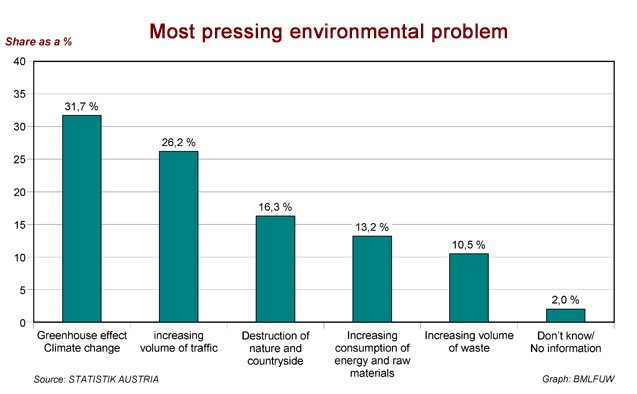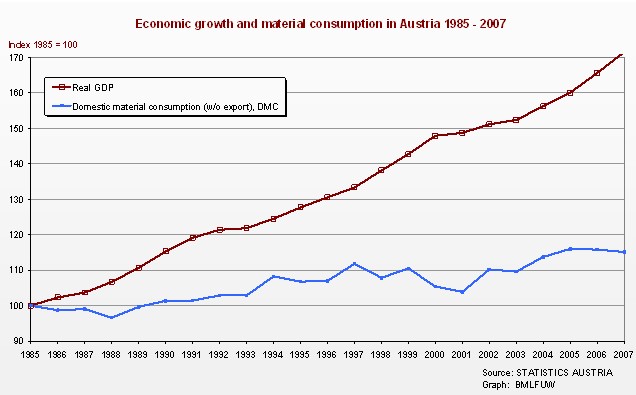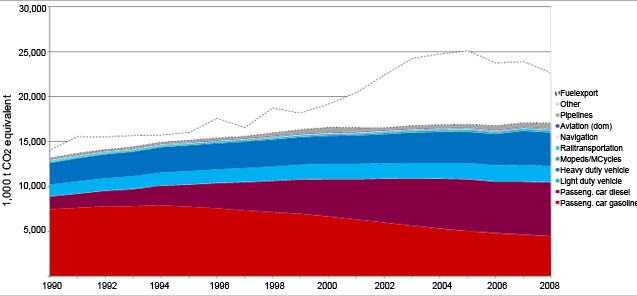Austria: Austria Environmental pressures in 2011
2011/07/02
Austria Environmental pressures
National surveys show the priority given by the Austrian population to environmental problems; see Figure 4 (STATISTIK AUSTRIA 2007).

The close match between the importance of environmental problems in terms of physical/technical assessment parameters and how they are evaluated by the public is striking. Only the importance attributed to the consumption of energy/natural resources, a main driver, is underrated. (BMLFUW Austrian Federal Ministry of Agriculture, Forestry, Environment and Water Management 2009B)
During the 1990s, Domestic Material Consumption (DMC) rose by an average of 0.5% per year, and between 2000 and 2006 by 0.9% per year (Figure 5).

Since 1990, primary energy consumption in Austria has increased by 36%, amounting to 1.429 PJ in 2008. The share of fossil fuels, to meet this consumption, is as high as 72%.
In 2008, the transport sector was the largest endconsumer of energy with 34%, of which almost 95% was from fossil fuels. Industry accounted for 29% of final energy consumption, private households for 25% and the services sector for 10%. Agriculture accounted for 2%. Final consumption of electricity rose between 1990 and 2008 by 39%, with the highest rise in manufacturing (STATISTIK AUSTRIA 2009A).
Related to this the development of GHG emissions are shown in Figure 7.

(The data are based on figures for sold fuels and therefore include fuel exports. Emissions produced by fuel export (passenger cars and heavy duty vehicles) are displayed separately. The difference in fuel prices between Austria and other countries has affected the data, particularly since 2001.)
A total of 31,373 km2 (37.4%) of the country's territory is currently available as permanent settlement area, i.e. as space available for agriculture, settlement and transport infrastructure. The associated areas used for building and transport purposes have increased by more than 6% since 2004 (BEV 2010). In contrast, the population has risen by 2.6% over a comparable period (STATISTIK AUSTRIA 2009B). Around 5 hectares per day are being sealed (BEV 2010).
The main reasons for making demands on the land are the increased standard of living and changes in the structure of society and the economy. The average living area per person rose from 22 m2 in 1971 to 36 m2 in 2001 (STATISTIK AUSTRIA 2004). Land designated for transport infrastructure purposes is increasingly being used for roads, with approximately 40% of the areas for building and transport purposes (BEV 2010).
The measures necessitated by dense settlement to protect against natural hazards and the intensive use of hydroelectric energy with the associated interference in aquatic ecology have resulted in some 63% of the waters failing to achieve the 'good status' required under the EU Water Framework Directive (BMLFUW 2010B).
The main Alpine crest acts as a natural barrier in Austria and, as such, is particularly exposed to longhaul air freight. Unlike other EU countries, this affects the sensitive highAlpine regions (Source: Austria and global environmental protection). Air currents from the northeast and southeast are frequently associated with aboveaverage SO2 and fine particulate air pollution in Austria.
The calculation models for modelling ambient air quality produce much less reliable results for Austria than for regions that are less strongly divided in orographical terms.
What are the foreseen developments?
Demographic forecasts assume a roughly stable population over the next ...
What are the foreseen main developments in coming decades that could be expected to contribute most to future environmental pressures
Demographic forecasts assume a roughly stable population over the next few decades without taking into account the immigration factor. If forecasts for immigration are included, the population could reach approximately 9.5 million by 2050.
As a consequence of the limited settlement area available and economic wealth, urban sprawl and land consumption occur in restricted areas, with resulting high pressures on the environment. Global warming and its consequences aggravate this pressure. These developments are one of the reasons why natural hazard and risk management in Austria is considered a key task in terms of policy development and implementation.
In order to combat climate change, increased efforts are required to reduce emissions. In addition, adaptation to climate change and its effects has to be accelerated, including provision for natural catastrophes (for example through implementation of the EU Floods Directive), the preservation of carbon dioxide sinks in forests and the further development of landuse planning. In general, efforts must be made to reverse the upward trend in material consumption and to increase resource efficiency through increased prevention of waste as well as increased waste recycling and/or reuse.
Land use is to be curbed in the future. For example, in order to move away from private motorised transport, public transport has to be promoted more strongly (UMWELTBUNDESAMT 2010A). In addition, a rise is anticipated in passenger and goods transport by rail, road and waterways (ROK 2008B).
There will also be effects on health, which cannot be ignored, for example owing to fine particulate emissions. There is some uncertainty regarding the as yet unknown future risks of, for example, flame retardants or nanomaterials. Technology is being further developed to counteract the rise in the emission of hazardous substances as a result of the increasing use of biomass.
The status of Austrias larger watercourses is to be improved by 2015, with action focussing on creating continuity, an incremental increase in quantities of residual water in diversion power plants and the local improvement of structures in water bodies and on their banks. The development of alternative energies and in this respect particularly the further development of hydroelectric energy in a manner compatible with the ecological objectives of surface waters is a particular challenge.
All in all, many of the trends described here have common characteristics, requiring integrated policy solutions. It will be increasingly important for a relatively small country like Austria, with a high research and development potential, to develop sustainable, stable solutions by increasing efficiency and taking even smarter measures in areas such as energy, resources, spatial planning and transport, and in particular by strengthening cooperation with the neighbouring regions.
At the same time it should be noted that the choice of the correct european policy instruments, along with their timing, quality and flexibility, is of key importance.
- Related Articles
-
Austria Fishery and Aquaculture Country Profiles
2012/01/01 更多 document.getElementById("bdshell_js").src = "http://share.baidu.com/static/js/shell_v2.js?t=" + new Date().getHours(); -
Austria Inflation Rate
2011/09/24 var addthis_config = { pubid: "YOUR PROFILE ID" } -
Imports
2011/09/24 var addthis_config = { pubid: "YOUR PROFILE ID" } -
Austria Exports
2011/09/24 var addthis_config = { pubid: "YOUR PROFILE ID" } Austria Exports -
Austria Current Account to GDP
2011/09/24 var addthis_config = { pubid: "YOUR PROFILE ID" }
-
- Austria News
-
- AUSTRIA: Austria Private Sector Growth Maintains Strong Momentum
- AUSTRIA: OPEC, non-OPEC agree first global oil pact since 2001
- AFGHANISTAN: Higher earning Why a university degree is worth more in some countries than others
- AUSTRIA: Minister Nkoana-Mashabane to host her Austrian counterpart
- ALBANIA: Europe in 2016: Terror fears, migration, politics. But economy may turn a corner
- AFGHANISTAN: Global growth will be disappointing in 2016: IMF's Lagarde
- Trending Articles
-
- QATAR: Qatar focuses on preventive care in new national health strategy
- SOUTH AFRICA: South Africa targets increased investment for food and beverages
- CHINA: Why China and Russia will be best frenemies forever
- CHINA: China energy regulator raises targets for curbing coal-fired power
- UNITED STATES: EU's Juncker says ready to retaliate if needed over new U.S. sanctions on Russia
- NIGERIA: The Federal Government Begs Dangote to Complete Refinery Before 2019









